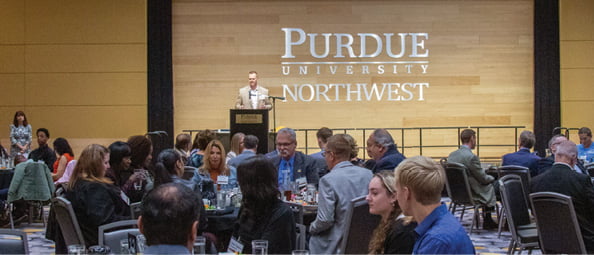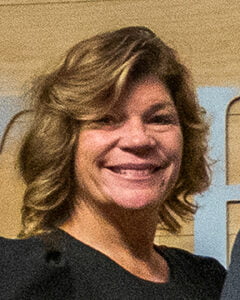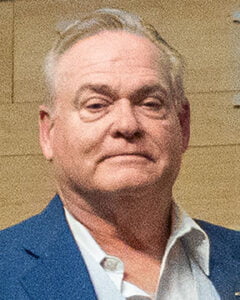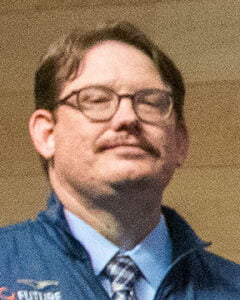Society of Innovators at PNW honors ideas of creative, determined 2023 inductees

The 2023 inductees to the Society of Innovators are driving growth in Northwest Indiana through the power of innovation.
“This is a place that punches above its weight class,” said Jason Williams, assistant director of The Society of Innovators. “We are changing the historical narrative about our Region. These awards shine a light on some of the folks in Northwest Indiana who are doing that.”
The Society’s annual awards recognize innovative individuals and teams across diverse industries and backgrounds. Business and community leaders gathered at a luncheon in October to honor the inductees and celebrate their achievements.
Gary Johnson, chairman of the board for the Society, reiterated that the event is the fulfillment of the Society’s mission.
“The purpose (of the Society) is to expand economic development in Northwest Indiana … our constant since our founding,” he said at the event.
Johnson also announced a five-year extension of the Society’s memorandum of understanding with PNW. The organization has been affiliated with PNW since 2018.
The now nonprofit was founded in 2004 through the vision of John Davies, its founding executive director, as a program of Ivy Tech Community College.
Those who developed this year’s innovations also earned their “wings.”
Here we share the stories of this year’s winners — how they took their ideas from concept to reality.
Stronger economy

Northwest Indiana features a lakeshore national park, sprawling cities and rich farmlands. Known for its higher education and health care institutions, the Region boasts the second largest economy in Indiana.
In 2017, however, the Northwest Indiana Forum identified a worrisome problem. Like many areas across the country, the Region was at a crossroads. Northwest Indiana faced stagnant job growth, job creation primarily in lower-wage service sectors and communities mired in persistent poverty. Despite all it had to offer, the Region was losing population.
The Northwest Indiana Forum, an economic development organization in Portage, made its mission to overcome those obstacles.
“We want to create the most vibrant economy in the Midwest through innovation, inclusivity and talent,” said Heather Ennis, president and CEO of the Forum.
With that goal in mind, they developed an initiative unlike any Northwest Indiana had seen before. They called it Ignite the Region: A Regional Strategy for Economic Transformation.
Ignite the Region is an economic development plan guided by five pillars: entrepreneurship and innovation, business development and marketing, infrastructure, placemaking and talent. The initiative brings together a coalition of partners from organizations and communities across the Region with the goal of revitalizing growth and building prosperity.
“Economic development is a team sport. It’s of interest to all of us,” Ennis said. “Previously we were working in cylinders of excellence — all doing great things but not all together. Now we’re doing it in concert. We can go so much farther together than we could on our own.”
The Northwest Indiana Forum sees change on the horizon as the Region moves beyond its traditional strengths for economic vitality.
“Someone asked the question ‘which came first, the chicken or the egg?’ Actually, the nest came first,” Ennis said. “This plan is to craft the nest.”
Community partnerships have laid groundwork for the initiative’s success and enabled their transformative vision.
“This is a great honor. We are lucky to have great leadership across the Region as partners to help us do the work,” Ennis said. “These leaders help to keep the flame of Ignite the Region alive. All these folks at the table continue to work hard day in and day out to move the needle.”
Ennis has been the champion of the movement, and she was rewarded for her efforts at the Ignite the Region luncheon Oct. 24. Gov. Eric Holcomb surprised her with a Sagamore of the Wabash award, which is one of the highest distinctions in the state.
Innovative painting

At times, Robert McShane felt like Sisyphus, a figure in Greek mythology sentenced to spend eternity rolling a boulder up a hill, only for it to roll back down as soon as he reached the top.
“I’ve had it roll back on me numerous times,” said McShane, founder and CEO of PowderCoil Technologies LLC in Crown Point.
McShane and his team faced multiple challenges while trying to develop a better method for painting metal in the manufacturing process.
Since the 1940s, companies have used liquid paint on metal. Approximately 6 million tons of metal are coated in the U.S. every year. Every pound is coated using liquid paint.
Liquid paint technology poses problems though. After being painted, the metal is dried in an industrial oven, releasing a volatile organic compound. When that substance is burned off, it emits about 2,500 pounds of carbon dioxide per hour into the atmosphere.
“Industrial companies have to report what is coming out of their stacks and how much,” McShane said. “In some cases, companies have met their environmental limit. They can take all the orders in the world, but they can’t make anymore. Powder paint is the answer because it emits zero.”
The dilemma with powder paint was how to apply it.
“Think of putting flour onto a moving strip of metal,” McShane said. “How do you put it on a piece of steel moving 100 feet per minute?”
McShane and his team eventually cracked the problem. By applying electrostatics to the powder paint, it becomes negatively charged. When the charged powder hits the surface of the metal, it sticks. The result is a uniform, scratch-resistant surface that doesn’t get damaged when the metal is formed into a shape.
They called the innovative technology “PowderCoil.” Their process saves time and money and is better for the environment.
“This is the future of pre-painted metals,” McShane said. “It’s the first of its kind on the planet.”
For McShane and his team, seeing their idea come to fruition is a testament to their teamwork and dedication to innovation.
“For a time, there was more steel made in the heart of Northwest Indiana than any place in America. We like that we’re in steel and aluminum because it’s native to the neighborhood,” McShane said. “Winning the award is just over the top.”
Mobile student support

Indiana has the nation’s highest student-to-counselor ratio — 694:1.
“Students in Northwest Indiana face significant challenges when it comes to determining solid post-high school career options due to high student-to-counselor ratios, limited college and career supports, and the effects of COVID-19 learning loss,” said Catisha Toney, founder and executive director of Coates Inc. in Merrillville.
Toney’s organization sees the gaps in educational equity for under served communities and aims to bridge them. Lake County, their core service area, has four cities with some of the highest poverty rates in Indiana. Technology barriers and 9-to-5 work schedules make it difficult for students and families in these communities to receive college and career readiness support.
To address the issue, Coates created the College and Career Mobile (CCM) — a resource center on wheels. It’s the only mobile college and career office in Indiana. Instead of students and families needing to seek out those services, the CCM can come to them.
The CCM provides high school transition planning, support for financial aid applications, college admissions assistance, and academic and career counseling for learners of all ages. Even adults looking to go back to school or to change career paths can use the service. Through the innovative CCM initiative, Coates hopes to help students achieve their goals and understand the different paths that can lead to success, whether through college or career.
“Because we are able to pull up to any location, we are able to impact multiple students, school districts and communities in a way that a stationary location cannot,” Toney said. “Our impact is high, and we are growing our partnerships daily. Our main mission through the CCM is to create a scaffolded approach to help young people successfully set goals beyond high school.”
Through the CCM, students and families can receive support no matter the time of day or location. The CCM has Wi-Fi and laptops, eliminating the technology barrier that some experience when they are out of school or without consistent technology resources.
“We are introducing a new way to bring college and career to the community,” Toney said. “We are literally meeting students where they are, and we are making a direct impact on how they plan for their futures.”
Being recognized by the Society of Innovators “means that we are doing something that no one else is doing,” Toney said.
Better batteries

The first known battery, the Parthian Battery, is believed to be more than 2,000 years old. It involved a clay jar, vinegar, iron and copper. People have been improving batteries ever since.
In 1859, a French physicist invented the lead acid battery, the first rechargeable battery. When lead is submerged into sulfuric acid, the resulting chemical reaction produces electricity. The reaction is reversed to recharge the battery.
People want powerful, long-lasting batteries that can be recharged numerous times. They also want batteries that don’t drain when devices are turned off but plugged in still.
The race has been on to build a better battery for years, spurred on by demand for renewable energy and electric automobiles. Hammond Group, in Hammond, is a chemical company in the battery and energy storage industry. They have developed an innovative electrode additive that improves reactions within the lead acid battery chemistry.
“Idle load electricity consumption wastes over 150 billion kilowatt hours of electricity each year at a cost of over $19 billion,” said Thomas Wojcinski, senior chemist at the Hammond Group. “These inefficiencies cause over 100 million metric tons of carbon dioxide emissions annually. Due to this waste, and the increased demand for rapid charging in energy storage systems, batteries are under constant need to improve their ability to accept charge quickly and more efficiently.”
Dubbed Treated SureCure, Hammond Group’s additive is the first of its kind, enhancing the life and performance of lead acid batteries with little increase in battery production cost and, in some cases, savings.
“This new additive product provides the potential to greatly improve partial state of charge battery performance, reduce energy consumption during the battery manufacturing process and help produce better energy storage solutions for the battery manufacturer, the consumer, our country and the world,” Wojcinski said.
Treated SureCure products are in production at Hammond Group’s new manufacturing facility.
“It is very gratifying to see an idea take shape, be tested and become successful. This is even more true when that success is recognized by others,” Wojcinski said. “We as innovators face many setbacks, which is why it is important to celebrate our successes and the success of others and to encourage one another even when we fail. All innovators are working toward the same goal, a better way to do things.”
Imaginative solutions

About 1.5 mobile phones are broken, lost or stolen every second, according to an AT&T survey. People drop them, dive into pools with them and leave them at restaurants. They can even become a dog’s expensive chew toy. Then comes the inevitable hassle and frustration of recovering lost phone numbers, messages and apps.
According to Forbes, 77% of people have lost or broken a cellphone in the last 10 years. Alejandra Alaniz’s invention provides a solution to the problem: a belt with a retractable tether that keeps phones and important personal possessions securely within reach.
Alaniz, owner of Tracktable Lifestyle in Valparaiso, invented the product of her dreams.
“I woke up at 2 in the morning and had a vision of myself using the retractor belt,” Alaniz said. “I looked all over the internet to buy the product that I dreamed of, and it didn’t exist.”
Alaniz told her husband what she saw in her dream, and he made her a prototype. A few days later they met with a patent attorney. Soon after, they had determined there was a good reason Alaniz hadn’t been able to find the product she’d envisioned — there was nothing like it on the market. Alaniz met with a retractor company to test different retractor strengths and materials before finalizing the product.
Alaniz’s innovative product features an adjustable spandex belt with a retractor box. The box holds a retractable leash that can be attached to a phone case. It also features a waterproof pouch that holds an ID card, a credit card, cash and keys. The Tracktable Lifestyle Retractor Box and Belt are designed to allow people to have easy access to their phones, while preventing possible loss and damage.
“Our products give our customers peace of mind,” Alaniz said. “It saves them time and gives them accessibility and functionality. When our customers start using our products, they become more productive because they no longer have to worry about misplacing or losing their smartphones.”
Alaniz is an individual inductee. Her story is quite literally a dream come true.
“It’s a great honor and a blessing to be inducted to the Society of Innovators,” she said.
Read more stories from the current issue of Northwest Indiana Business Magazine.

